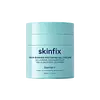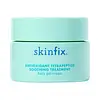What's inside
What's inside
 Key Ingredients
Key Ingredients

 Benefits
Benefits

 Concerns
Concerns

No concerns
 Ingredients Side-by-side
Ingredients Side-by-side

Water
Skin ConditioningSqualane
EmollientPropanediol
SolventJojoba Oil/Macadamia Seed Oil Esters
Skin ConditioningTriheptanoin
Skin ConditioningNiacinamide
SmoothingSaccharide Isomerate
HumectantAmmonium Acryloyldimethyltaurate/Vp Copolymer
Squalene
EmollientZinc PCA
HumectantHydrolyzed Hyaluronic Acid
HumectantGlycerin
HumectantCamellia Sinensis Seed Extract
HumectantAllantoin
Skin ConditioningPhytosteryl Macadamiate
Skin ConditioningPhytosterols
Skin ConditioningAcetyl Glutamine
Skin ConditioningLecithin
EmollientCaprylyl Glycol
EmollientAmylopectin
Sodium Hyaluronate
HumectantFolic Acid
Skin ConditioningOligopeptide-3
Skin ConditioningBacillus/Soybean Ferment Extract
Skin ConditioningOligopeptide-1
Skin ConditioningOligopeptide-2
Skin ConditioningHexapeptide-11
Skin ConditioningTocopherol
AntioxidantLithothamnion Calcareum Extract
Skin ConditioningLactic Acid
BufferingGlucose
HumectantAcetyl Heptapeptide-4
HumectantC14-22 Alcohols
Emulsion StabilisingC12-20 Alkyl Glucoside
EmulsifyingEthylhexylglycerin
Skin ConditioningTrisodium Ethylenediamine Disuccinate
Potassium Sorbate
PreservativeCitric Acid
BufferingSodium Citrate
BufferingPentylene Glycol
Skin ConditioningSodium Benzoate
MaskingXanthan Gum
EmulsifyingPhenoxyethanol
PreservativeWater, Squalane, Propanediol, Jojoba Oil/Macadamia Seed Oil Esters, Triheptanoin, Niacinamide, Saccharide Isomerate, Ammonium Acryloyldimethyltaurate/Vp Copolymer, Squalene, Zinc PCA, Hydrolyzed Hyaluronic Acid, Glycerin, Camellia Sinensis Seed Extract, Allantoin, Phytosteryl Macadamiate, Phytosterols, Acetyl Glutamine, Lecithin, Caprylyl Glycol, Amylopectin, Sodium Hyaluronate, Folic Acid, Oligopeptide-3, Bacillus/Soybean Ferment Extract, Oligopeptide-1, Oligopeptide-2, Hexapeptide-11, Tocopherol, Lithothamnion Calcareum Extract, Lactic Acid, Glucose, Acetyl Heptapeptide-4, C14-22 Alcohols, C12-20 Alkyl Glucoside, Ethylhexylglycerin, Trisodium Ethylenediamine Disuccinate, Potassium Sorbate, Citric Acid, Sodium Citrate, Pentylene Glycol, Sodium Benzoate, Xanthan Gum, Phenoxyethanol
Water
Skin ConditioningGlycerin
HumectantTridecyl Neopentanoate
EmollientCetearyl Ethylhexanoate
EmollientOlus Oil
EmollientPropanediol
SolventGlyceryl Stearate Citrate
EmollientAmmonium Acryloyldimethyltaurate/Vp Copolymer
Vitis Vinifera Seed Oil
EmollientIsosorbide Disunflowerseedate
HumectantIsosorbide Dicaprylate
Skin ConditioningTetrapeptide-14
Skin ConditioningEchium Plantagineum Seed Oil
Skin ConditioningAspalathus Linearis Extract
Skin ConditioningHydrolyzed Hyaluronic Acid
HumectantMel Extract
MoisturisingBoswellia Serrata Extract
Skin ConditioningCeramide NP
Skin ConditioningPhytosphingosine
Skin ConditioningCeramide AP
Skin ConditioningCholesterol
EmollientCeramide EOP
Skin ConditioningColloidal Oatmeal
AbsorbentRosa Damascena Flower Water
MaskingCucumis Sativus Fruit Water
Skin ConditioningSimmondsia Chinensis Seed Wax
Skin ConditioningOlea Europaea Husk Oil
Skin ConditioningHelianthus Annuus Seed Oil
EmollientCamellia Sinensis Leaf Extract
AntimicrobialAloe Barbadensis Leaf Juice
Skin ConditioningTocopherol
AntioxidantTrisodium Ethylenediamine Disuccinate
Butylene Glycol
HumectantXanthan Gum
EmulsifyingEthylhexylglycerin
Skin ConditioningSodium Lauroyl Lactylate
EmulsifyingCarbomer
Emulsion StabilisingPhenoxyethanol
PreservativePotassium Sorbate
PreservativeSodium Benzoate
MaskingCitric Acid
BufferingCI 75810
Cosmetic ColorantWater, Glycerin, Tridecyl Neopentanoate, Cetearyl Ethylhexanoate, Olus Oil, Propanediol, Glyceryl Stearate Citrate, Ammonium Acryloyldimethyltaurate/Vp Copolymer, Vitis Vinifera Seed Oil, Isosorbide Disunflowerseedate, Isosorbide Dicaprylate, Tetrapeptide-14, Echium Plantagineum Seed Oil, Aspalathus Linearis Extract, Hydrolyzed Hyaluronic Acid, Mel Extract, Boswellia Serrata Extract, Ceramide NP, Phytosphingosine, Ceramide AP, Cholesterol, Ceramide EOP, Colloidal Oatmeal, Rosa Damascena Flower Water, Cucumis Sativus Fruit Water, Simmondsia Chinensis Seed Wax, Olea Europaea Husk Oil, Helianthus Annuus Seed Oil, Camellia Sinensis Leaf Extract, Aloe Barbadensis Leaf Juice, Tocopherol, Trisodium Ethylenediamine Disuccinate, Butylene Glycol, Xanthan Gum, Ethylhexylglycerin, Sodium Lauroyl Lactylate, Carbomer, Phenoxyethanol, Potassium Sorbate, Sodium Benzoate, Citric Acid, CI 75810
 Reviews
Reviews

Ingredients Explained
These ingredients are found in both products.
Ingredients higher up in an ingredient list are typically present in a larger amount.
Ammonium Acryloyldimethyltaurate/Vp Copolymer (let's call it AAVC for short) is a synthetically created polymer. It's used as a film-forming agent and used to thicken the consistency of products.
AAVC is able to increase the consistency and viscosity of products due to its large molecule size. It also prevents ingredients from separating.
Citric Acid is an alpha hydroxy acid (AHA) naturally found in citrus fruits like oranges, lemons, and limes.
Like other AHAs, citric acid can exfoliate skin by breaking down the bonds that hold dead skin cells together. This helps reveal smoother and brighter skin underneath.
However, this exfoliating effect only happens at high concentrations (20%) which can be hard to find in cosmetic products.
Due to this, citric acid is usually included in small amounts as a pH adjuster. This helps keep products slightly more acidic and compatible with skin's natural pH.
In skincare formulas, citric acid can:
While it can provide some skin benefits, research shows lactic acid and glycolic acid are generally more effective and less irritating exfoliants.
Most citric acid used in skincare today is made by fermenting sugars (usually from molasses). This synthetic version is identical to the natural citrus form but easier to stabilize and use in formulations.
Read more about some other popular AHA's here:
Learn more about Citric AcidEthylhexylglycerin (we can't pronounce this either) is commonly used as a preservative and skin softener. It is derived from glyceryl.
You might see Ethylhexylglycerin often paired with other preservatives such as phenoxyethanol. Ethylhexylglycerin has been found to increase the effectiveness of these other preservatives.
Glycerin is already naturally found in your skin. It helps moisturize and protect your skin.
A study from 2016 found glycerin to be more effective as a humectant than AHAs and hyaluronic acid.
As a humectant, it helps the skin stay hydrated by pulling moisture to your skin. The low molecular weight of glycerin allows it to pull moisture into the deeper layers of your skin.
Hydrated skin improves your skin barrier; Your skin barrier helps protect against irritants and bacteria.
Glycerin has also been found to have antimicrobial and antiviral properties. Due to these properties, glycerin is often used in wound and burn treatments.
In cosmetics, glycerin is usually derived from plants such as soybean or palm. However, it can also be sourced from animals, such as tallow or animal fat.
This ingredient is organic, colorless, odorless, and non-toxic.
Glycerin is the name for this ingredient in American English. British English uses Glycerol/Glycerine.
Learn more about GlycerinHydrolyzed Hyaluronic Acid is a form of hyaluronic acid. It is created by the hydrolysis of hyaluronic acid with a high molecular weight. Once created, Hydrolyzed Hyaluronic Acid has a low molecular weight.
Low molecular weight HA has been shown to hydrate and increase elasticity of the skin. Increasing elasticity is also associated with reduction of wrinkle depth.
One study found topical low molecular weight hyaluronic acid may be considered for the treatment of rosacea in the adult population. However, we always recommend speaking with a professional about your skin concerns.
Hyaluronic acids are a humectant. This means they draw moisture from the air. Hyaluronic acids help moisturize, soothe, and protect the skin.
Read more about other common forms of hyaluronic acid:
Learn more about Hydrolyzed Hyaluronic AcidPhenoxyethanol is a preservative that has germicide, antimicrobial, and aromatic properties. Studies show that phenoxyethanol can prevent microbial growth. By itself, it has a scent that is similar to that of a rose.
It's often used in formulations along with Caprylyl Glycol to preserve the shelf life of products.
Potassium Sorbate is a preservative used to prevent yeast and mold in products. It is commonly found in both cosmetic and food products.
This ingredient comes from potassium salt derived from sorbic acid. Sorbic acid is a natural antibiotic and effective against fungus.
Both potassium sorbate and sorbic acid can be found in baked goods, cheeses, dried meats, dried fruit, ice cream, pickles, wine, yogurt, and more.
You'll often find this ingredient used with other preservatives.
Learn more about Potassium SorbatePropanediol is an all-star ingredient. It softens, hydrates, and smooths the skin.
It’s often used to:
Propanediol is not likely to cause sensitivity and considered safe to use. It is derived from corn or petroleum with a clear color and no scent.
Learn more about PropanediolSodium Benzoate is a preservative. It's used in both cosmetic and food products to inhibit the growth of mold and bacteria. It is typically produced synthetically.
Both the US FDA and EU Health Committee have approved the use of sodium benzoate. In the US, levels of 0.1% (of the total product) are allowed.
Sodium benzoate works as a preservative by inhibiting the growth of bacteria inside of cells. It prevents the cell from fermenting a type of sugar using an enzyme called phosphofructokinase.
It is the salt of benzoic acid. Foods containing sodium benzoate include soda, salad dressings, condiments, fruit juices, wines, and snack foods.
Studies for using ascorbic acid and sodium benzoate in cosmetics are lacking, especially in skincare routines with multiple steps.
We always recommend speaking with a professional, such as a dermatologist, if you have any concerns.
Learn more about Sodium BenzoateTocopherol (also known as Vitamin E) is a common antioxidant used to help protect the skin from free-radicals and strengthen the skin barrier. It's also fat soluble - this means our skin is great at absorbing it.
Vitamin E also helps keep your natural skin lipids healthy. Your lipid skin barrier naturally consists of lipids, ceramides, and fatty acids. Vitamin E offers extra protection for your skin’s lipid barrier, keeping your skin healthy and nourished.
Another benefit is a bit of UV protection. Vitamin E helps reduce the damage caused by UVB rays. (It should not replace your sunscreen). Combining it with Vitamin C can decrease sunburned cells and hyperpigmentation after UV exposure.
You might have noticed Vitamin E + C often paired together. This is because it is great at stabilizing Vitamin C. Using the two together helps increase the effectiveness of both ingredients.
There are often claims that Vitamin E can reduce/prevent scarring, but these claims haven't been confirmed by scientific research.
Learn more about TocopherolTrisodium Ethylenediamine Disuccinate is used to help stabilize a product.
It is a chelating agent, meaning it helps prevent metal ions from binding to other ingredients. This prevents unwanted reactions in products. Metal ions can come into a product via the water ingredient. They are found in trace amounts and are not known to be harmful.
Water. It's the most common cosmetic ingredient of all. You'll usually see it at the top of ingredient lists, meaning that it makes up the largest part of the product.
So why is it so popular? Water most often acts as a solvent - this means that it helps dissolve other ingredients into the formulation.
You'll also recognize water as that liquid we all need to stay alive. If you see this, drink a glass of water. Stay hydrated!
Learn more about WaterXanthan gum is used as a stabilizer and thickener within cosmetic products. It helps give products a sticky, thick feeling - preventing them from being too runny.
On the technical side of things, xanthan gum is a polysaccharide - a combination consisting of multiple sugar molecules bonded together.
Xanthan gum is a pretty common and great ingredient. It is a natural, non-toxic, non-irritating ingredient that is also commonly used in food products.
Learn more about Xanthan Gum